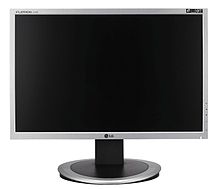16:10 aspect ratio

16:10, also known as 8:5, is an aspect ratio mostly used for computer displays. The width of the display is 1.6 times its height.
LCD computer displays using the 16:10 ratio started to appear in the mass market from 2003. By 2008 16:10 had become the most common aspect ratio for LCD monitors and laptop displays.[1] Since 2010, however, 16:9 has the become the mainstream standard, driven by the 1080p standard for high definition television.[2][3]
History
Computer Displays
Industry moves towards 16:10 from 2003 to 2008
Until about 2003, most computer monitors had a 4:3 aspect ratio and some had 5:4. Between 2003 and 2006, monitors with 16:10 (8:5) aspect ratios became commonly available, first in laptops and later also in standalone monitors. Reasons for this transition were productive uses for such monitors, i.e. besides widescreen movie viewing and computer game play, are the word processor display of two standard letter pages side by side, as well as CAD displays of large-size drawings and CAD application menus at the same time.[4][5]
In 2005-2008, 16:10 took over the position from 4:3 as the most sold aspect ratio for LCD monitors. At the time, 16:10 also had 90 percent of the notebook market and was the most common used aspect ratio for laptops.[2] However, 16:10 had a short reign as the most common aspect ratio.
Industry moves away from 16:10 in 2008 to 16:9
Around 2008-2010, there was a rapid shift by computer display manufacturers to the 16:9 aspect ratio, and by 2011, 16:10 had almost disappeared from new mass market products.
The primary reason for this move is considered to be production efficiency[3][6] - since display panels for TVs use the 16:9 aspect ratio, it's more efficient for display manufacturers to produce computer display panels in the same aspect ratio as well.[7] A 2008 report by DisplaySearch also cited a number of other reasons, including the ability for PC and monitor manufacturers to provide higher resolutions and diversify their products, "stimulating the growth of the notebook PC and LCD monitor market".[2]
Unlike the previous move from 4:3 to 16:10, this move has been met with a more mixed response. While the lower cost of 16:9 computer displays, along with the convenience of having the same aspect ratio in different devices, has been seen as a positive,[3] many consider 16:9 to be inferior to 16:10 for productivity-oriented tasks (such as Internet browsing, editing documents or spreadsheets, and using professional design and engineering applications), which benefit more from vertical resolution, rather than horizontal.[8][9][10][11]
Tablets
Tablets became a popular during the late 00s. The first tablets was in 4:3 but 16:10 tablets became soon popular.
Mobile Phones
In late 00s 16:10 became very popular in mobile phones. During 2012 there has been a shift to 16:9 but Apple still produce there mobile phones in 16:10.
16:10 Ratio Properties
The 16:10 (8:5) ratio, at 1.6, is close to the golden ratio (1.618..., often denoted φ). 5 and 8 are consecutive numbers in the Fibonacci sequence; that's why the 8/5 ratio is a close rational approximation to phi, the golden number.
Common screen resolutions of 16:10 screens
| Name | Dimensions | Diagonal screen size |
|---|---|---|
| WXGA | 1280×800 | 13–15 in (33–38 cm) |
| WXGA+ | 1440×900 | 13–19 in (33–48 cm) |
| WSXGA+ | 1680×1050 | 15–22 in (38–56 cm) |
| WUXGA | 1920×1200 | 17–28 in (43–71 cm) |
| WQXGA | 2560×1600 | 30 in (76 cm) |
See also
- Display aspect ratio - Different aspect ratios for computer monitors.
- Aspect ratio (image)
- Computer display standard
References
- ^ http://lowendmac.com/musings/08mm/10-percent-notebook.html
- ^ a b c http://www.displaysearch.com/cps/rde/xchg/SID-0A424DE8-28DF6E59/displaysearch/hs.xsl/070108_16by9_PR.asp Cite error: The named reference "display" was defined multiple times with different content (see the help page).
- ^ a b c http://www.engadget.com/2008/07/02/widescreen-lcds-going-widescreen-by-2010/
- ^ NEMATech Computer Display Standards http://www.millertech.com/Technical_Specs.htm
- ^ "Introduction--Monitor Technology Guide". necdisplay.com. Archived from the original on 2007-03-15. (currently offline)
- ^ Miller, Michael J. (2008-03-21). "Where Displays Are Heading". PC Magazine. Retrieved 2012-07-09.
- ^ Kowaliski, Cyril (2008-07-02). "DisplaySearch: Transition to 16:9 displays is 'unstoppable'". The Tech Report. Retrieved 2012-07-09.
- ^ Ghazi, Koroush (April 2012). "The Gamer's Graphics & Display Settings Guide". TweakGuides. Retrieved 2012-07-09.
- ^ Orion, Egan (2010-06-11). The Inquirer http://www.theinquirer.net/inquirer/opinion/1652880/time-ditch-awful-hd-1080p-widescreens. Retrieved 2012-07-09.
{{cite web}}: Missing or empty|title=(help) - ^ "Gateway's 16:10 displays show common sense". The Inquirer. 2010-07-16. Retrieved 2012-07-09.
- ^ Ulanoff, Lance (2008-08-27). "Stop Shrinking My Laptop Screen". PC Magazine. Retrieved 2012-07-09.
